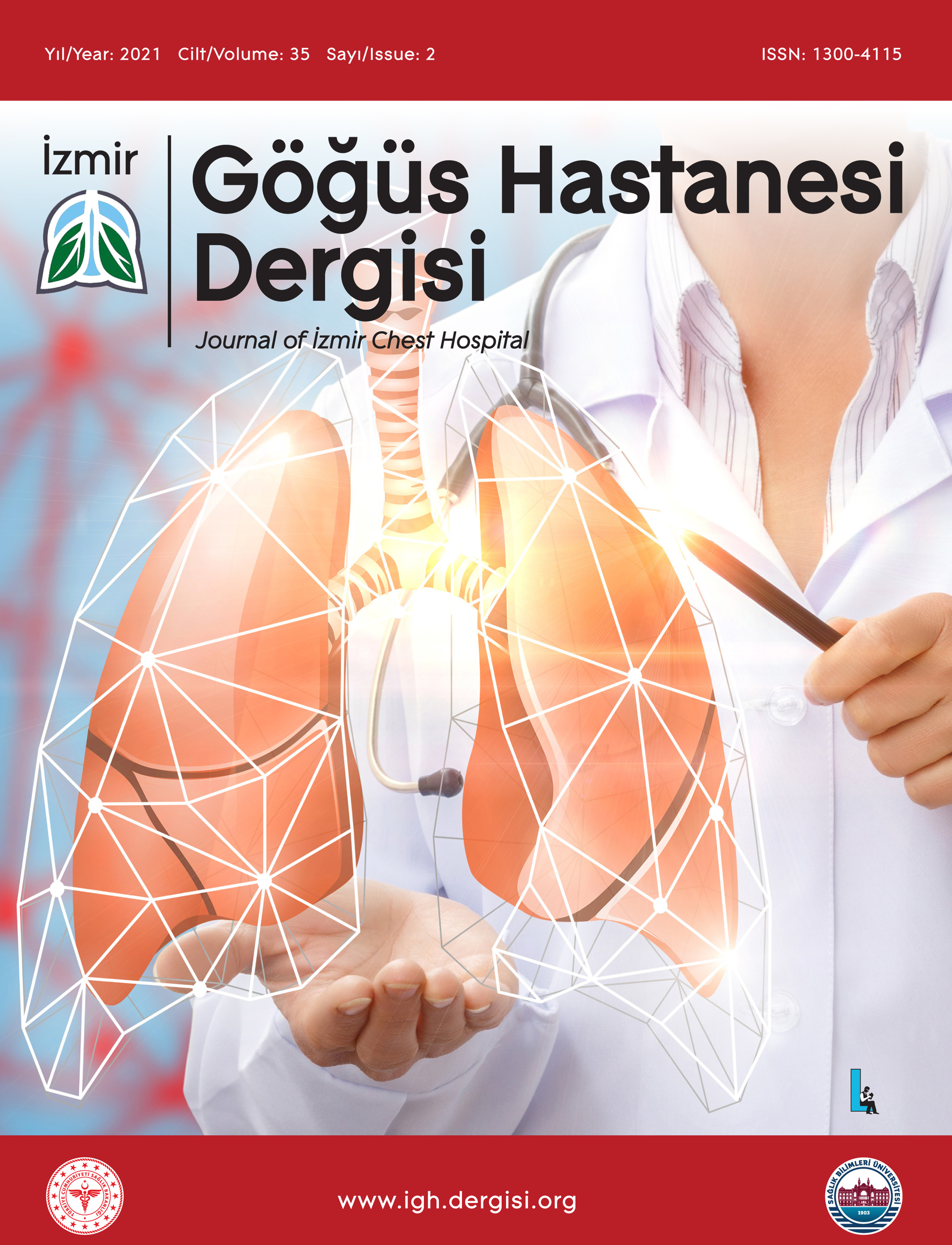Phenotypic Features of Emphysema in Patients with Lung Cancer and COPD Coexistence
Nuran Katgı1, Pınar Çimen1, Seher Susam2, Fatma Fevziye Tuksavul11Sağlık Bilimleri Üniversitesi, Dr. Suat Seren Göğüs Hastalıkları ve Cerrahisi Eğitim ve Araştırma Hastanesi, Göğüs Hastalıkları Bölümü, İzmir, Türkiye.2Sağlık Bilimleri Üniversitesi, Radyoloji Anabilim Dalı, Dr. Suat Seren Göğüs Hastalıkları ve Cerrahisi Eğitim ve Araştırma Hastanesi, İzmir, Türkiye
Amaç: Çalışmada, akciğer kanseri ve kronik obstrüktif akciğer hastalığı (KOAH) birlikteliğinde amfizemin fenotipik özellikleriyle ilişkisi incelendi.
Gereç ve Yöntemler: Bu çalışmada, 01 Ocak 2016 ve 31 Aralık 2018 tarihleri arasında akciğer kanseri tanısı almış, aynı zamanda KOAH tanısı da bulunan hastalar retrospektif olarak değerlendirildi.
Bulgular: Çalışmada 248 hasta değerlendirildi. Amfizemin fenotipi ve şiddeti ile tümörün histolojik tip ve lokalizasyonu arasında ilişki bulunmadı. Ancak vizüel amfizem fenotipleri ile beden kitle indeksi (BKİ) (p=0,003) ve birinci saniyedeki zorlu ekspiratuvar volüm (FEV1)/zorlu vital kapasite (FVC) (p=0,003), sentrilobüler amfizem şiddeti ile BKİ (p<0,001), FEV1 (p=0,004), FEV1/FVC (p<0,001) ve paraseptal amfizem ile BKİ (p=0,003) arasında anlamlı ilişki saptandı. Ayrıca KOAH evreleri ve BKİ (p=0,007), FEV1 (p<0,001), FEV1/FVC (p<0,001), cerrahi oranı (p<0,001) arasında da anlamlı ilişki tespit edildi. Akciğer kanseri ile tümör lokalizasyonu (p<0,001), histolojik tip (p=0,018) ve cerrahi oranı (p<0,001) arasında da anlamlı ilişki gözlendi.
Sonuç: Parankim hasarıyla giden amfizemin bilgisayarlı tomografinin kantitatif değerlendirilmesiyle ortaya konulan vizüel tip ve cid-diyeti ile akciğer kanserinin histolojik tip ve lokalizasyonu arasında herhangi bir ilişki saptanmadı. Hasta popülasyonunun %72,2sinde izlenen sentrilobüler amfizem anlamlı bir oran olsa da kontrol grubunun yokluğu nedeniyle istatistiksel değerlendirme yapılmadı. Literatüre bakıldığında da vizüel amfizem fenotiplerinin şiddeti ile akciğer kanseri arasındaki ilişkiyi inceleyen herhangi bir çalışma bulunmadı. İleride daha fazla hasta sayısı ile kontrol grubu içeren çalışmalara gereksinim bulunmaktadır.
Akciğer Kanseri ve Kronik Obstrüktif Akciğer Hastalığı Birlikteliği Olan Hastalarda Amfizemin Fenotipik Özellikleri
Nuran Katgı1, Pınar Çimen1, Seher Susam2, Fatma Fevziye Tuksavul11Department of Chest Diseases, University of Health Sciences, Dr. Suat Seren Chest Diseases and Surgery Training and Research Hospital, Izmir, Türkiye2Department of Radiology, University of Health Sciences, Dr. Suat Seren Chest Diseases and Surgery Training and Research Hospital, Izmir, Türkiye
Objective: In this study, we examined the relationship between the phenotypic features of emphysema in the coexistence of lung cancer and chronic obstructive pulmonary disease (COPD).
Material and Methods: Patients who were diagnosed with lung cancer and had concurrent COPD in a pulmonology department of a training and research hospital between January 1, 2016, and December 31, 2018, were retrospectively evaluated.
Results: A total of 248 patients were evaluated. In our study, no correlation was found between the phenotype and severity of emphysema and lung cancer, and also no relation was found between histological type and localization of the tumor. However, there was a significant difference between the visual emphysema phenotypes and body mass index (BMI) (p=0.003) and forced expiratory volume in 1 second/forced vital capacity (FEV1/FVC) (p=0.003), centrilobular emphysema (CLE) severity and BMI (p<0.001), FEV1 (p=0.004), FEV1/FVC (p<0.001), and paraseptal emphysema, and BMI (p=0.003). Furthermore, there was a significant difference between COPD stages and BMI (p=0.007), FEV1 (p<0.001), FEV1/FVC (p<0.001), and surgery rate (p=0.001). A significant correlation was observed between lung cancer and localization of tumor (p<0.001), histological type (p=0.018), and surgery rate (p<0.001).
Conclusion: No correlation was found between the visual type and severity of emphysema associated with parenchymal damage, as revealed by the quantitative evaluation of computed tomography, and the histological type and location of lung cancer. Although a significant rate of CLE was observed in 72.2% of our patient population, it could not be statistically documented due to the absence of our control group. The fact we could not find any study in the literature examining the relationship between the severity of visual emphysema phenotypes and lung cancer. Hence, this subject requires further studies with a larger number of patients and a control group.
Makale Dili: İngilizce






